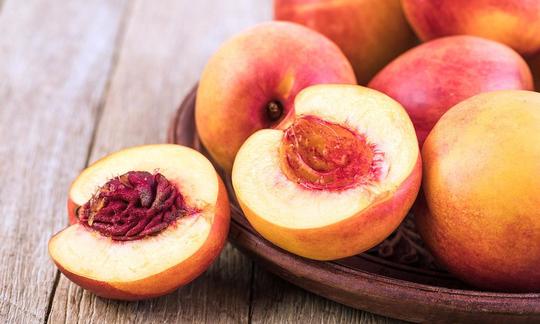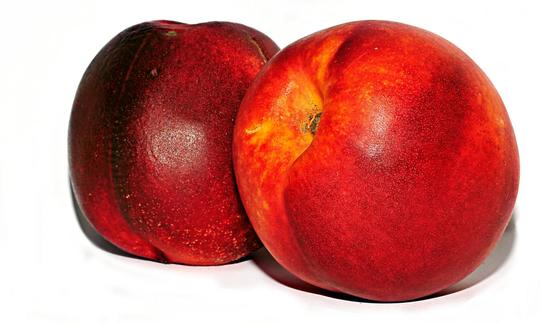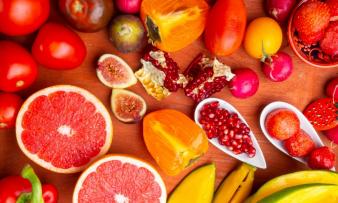Table of contents
The nectarine ( Prunus persica var. nucipersica or var. nectarina) is a mutation of the peach. It is considered one of the sweetest stone fruits. It is also known as the naked peach or smooth peach.
Use in the kitchen:
Nectarines taste best when fresh and raw, but they can also be cooked. When ripe, the fruit contains a lot of juice, which can easily get all over your body. It is therefore advisable to cut smooth peaches into bite-sized pieces after washing them. When cutting nectarines, you should first carefully cut vertically around the stone. The fruit can then often be broken into two pieces by hand. The nectarines intended for sale are usually easy to remove the stone. The flesh of the nectarine is white, yellowish or reddish, depending on the variety, and tastes very sweet and delicious.
The fruit pieces therefore go well in a fruit salad or muesli. When cooked, the pureed pulp can be used to make jam, compote or chutneys. When pureed, the nectarine pulp is ideal for use in various desserts. Nectarine juice can be used to give salad dressings and other sauces a special, fruity note. The freshness and juiciness of nectarines can be combined excellently with other fruits in a fruit drink.
Recipe for a vitamin-rich smoothie with nectarines:
Put 3 washed, fully ripe organic nectarines cut into pieces (without seeds), 1 fully ripe banana, 10 cleaned organic strawberries, together with a handful of ice cubes in the blender. When the fruit has produced a thick, almost creamy mixed drink, add 50 ml of apple juice. If necessary, you can season the vegan raw fruit drink with raw sugar. A few organic mint leaves give the smoothie a special touch. 1
Recipe for a nectarine salad with sweet potatoes
Cut 2-3 large sweet potatoes, with or without skin, into cubes after cooking. Then cut 3 washed, fully ripe organic nectarines into slices, cubes or wedges and put them in a bowl with the sweet potatoes. Also add a handful of chopped pecans and a bunch of chopped fresh mint (organic) to the bowl. Add oil, a little salt and pepper to taste to transform the sweetness of the vegetables and fruit into a salad. 2
Shopping - where to buy?
The nectarine is a typical summer fruit. The first fruits are available in stores as early as the beginning of May. During the main harvest period, however, the aroma of the fruit is more intense than that of the early-ripening varieties. During the actual season from June to September (Southern Europe) or August to September (in more northern regions), nectarines can be bought everywhere from the various large retailers or fruit dealers. The fruits are usually found next to their relatives, the peaches. Sales outlets such as Coop, Migros, Denner, Volg, Spar, Aldi, Lidl, Rewe, Edeka, Hofer etc. present the two types of fruit separately and clearly labelled on their fruit shelves.
The nectarine is a round fruit with a diameter of about 10 cm and weighs about 100-125 g. A ripe fruit has a red-yellow, smooth, shiny skin. An unripe nectarine has not yet turned from green to yellow. A light pressure with your finger on the fruit reveals its degree of ripeness. If the fruit is still hard, it is better not to buy it. The nectarine is not a fruit that ripens well at home. Fruit harvested just a little too early will never reach a good level of ripeness. You should also not buy fruit with shriveled skin or damaged areas. Such nectarines are overripe and will rot quickly.
Depending on the variety, the flesh of the nectarine is white, yellow or marbling red. The price of white-fleshed fruits is usually higher because they are particularly aromatic and juicy.
Nectarines often require spraying, so washing the fruit does not wash away the pesticide residues sufficiently. It is therefore worth paying attention to controlled organically grown fruit. 6
The 1.5-2.5 cm large, deeply grooved fruit stone of the nectarine can belong to a stone-removing or stone-adhering variety. The stone-adhering fruit varieties are mainly used for canning. If you buy canned nectarines, you should prefer products with as low a sugar content as possible. 5
Some mixed juices contain nectarine juice, which gives them a refreshing note. Dried nectarine pieces also taste delicious. It is important that the fruit or pieces of fruit you buy are organically grown, natural and not sugared or artificially preserved. You can sometimes get pre-cut nectarine pieces in a delicatessen or from a specialised fruit dealer.
Many delicatessens offer Persipan cubes. This is a sweet similar to marzipan. It is made from peach, nectarine or apricot kernels. The name is a portmanteau of the Latin " persicus" Peach and "pan" bread. For the bitter-tasting Persipan mass, special apricots are even grown that are not edible. In contrast to these, edible apricots contain sweet kernels. 7,8
Found in the wild:
The nectarine ( Prunus persica var. nucipersica) is a mutation of the peach and is only found in cultivation. There are also wild varieties of the peach ( Prunus persica).
Storage:
If the fruit is already ripe when you buy it, you have to process it quickly or eat it straight away. Ripe and undamaged fruit can be stored for a short time in the vegetable compartment of the refrigerator. However, they must not be placed next to each other, otherwise they will quickly rot.
Always store nectarines separately because they release the natural plant hormone ethylene. This causes other types of fruit to ripen more quickly – but also spoil more quickly. 9
Nectarines can be easily frozen when cut into pieces or pureed. Frozen or preserved fruit does not have as many nutrients as fresh fruit, but you can enjoy the aroma all year round. 5
Ingredients - nutritional value - calories:
A nectarine weighing 100 grams consists mainly of water, contains 8% sugar and hardly any protein. It is also almost fat-free. So it is extremely low in calories despite its good, fresh taste.
How many vitamins does a nectarine have? The vitamin C content is not particularly high for a fruit at 5.4 mg/100g. Strawberries provide significantly more vitamin C at 58 mg/100g. 100 g of a nectarine cover 7% of the average daily requirement of niacin. So you can say that with 1.1 mg/100g, a fruit contains a lot of niacin - walnuts and sweet chestnuts have similar values. As sources of vitamin E, nectarines and peaches are as good as beef tomatoes or spelt. There are also small amounts of vitamin K and folate in nectarines. 10
The amount of the mineral potassium is 201 mg/100g, which is similar to that of quince or peach. The trace element copper is essential, but we usually get enough of it. You can find detailed information in the ingredient tables after the text. 10
Health aspects - effects:
How healthy is a nectarine? The close relationship to the peach reveals a similarly healthy pattern. The vitamin C contained in nectarines strengthens the immune system and acts as a radical scavenger. The plant fibers contain secondary plant substances such as cellulose. These fibers stimulate digestion. Vitamin E is important for cell renewal and also inhibits inflammatory processes. Niacin helps with the utilization of fats, proteins and carbohydrates. It is also useful for skin and nails.
Potassium plays a central role in the transmission of stimuli in the nervous system and in regulating the body's water balance. Potassium also ensures that the muscles work well. It helps regulate blood pressure and is a component of the digestive juices in the gastrointestinal tract.
Copper contributes to the maintenance of normal connective tissue, plays an important role as an antioxidant, in energy metabolism, in the nervous system and in iron transport. It helps against loss of appetite and bouts of weakness, but vegans always get enough of it with a reasonably balanced diet.
Dangers - Intolerances - Side effects:
The seeds can be poisonous in large quantities. They contain about 6.5% hydrocyanic acid, a splitting amygdalin. The leaves contain a related hydrocyanic acid glycoside. 11
Folk medicine - natural medicine:
Since the nectarine is a bud mutation of the peach, it also has similar healthy properties to the peach: The cooling and moisturizing effect of peaches has always been valued in monastic medicine. In the 200-year-old 'Complete Herbal' by the English doctor Culpeper, there is a long list of peach indications. He says that the syrup made from the flowers and leaves is used to cleanse the bile and to treat jaundice. He describes the precious oil, which makes up almost half of the kernels, as a beauty product for the skin. 6
Hildegard von Bingen described various medicinal uses of the peach in more detail. 12 The unripe fruits including the seeds, the leaves, the resin of the tree bark and even the root are used externally for watery eyes, gout and headaches. 13
Occurrence:
Where does the nectarine come from? Nectarines were supposedly known in central and northern China thousands of years ago. Before the fruit came to Europe, the Persians and Greeks cultivated nectarines. The botanical name Prunus persica var. nucipersica or var. nectarina certainly suggests this. The nectarine has been known as a cultivated plant in England since the 17th century. The nectarine only gained attention in the last few decades, through breeding in the United States.
In Europe, Spain (early ripe varieties), Italy, France and Greece are the main suppliers of the tasty fruit. In the winter months, the fruits imported into Europe come from Chile, South Africa and America. Nectarine cultivation is also an important economic sector in Egypt, Turkey, South Africa and China. 4.3
Nectarines also thrive in subtropical summer rain areas and at higher altitudes in the tropics. However, in these areas, winter temperatures must be cool enough to break the bud dormancy. There are large differences in the winter cold requirements of the different peach varieties. 14
Cultivation - Harvest:
A nectarine tree can reach an age of up to 30 years. However, it does not bear its first fruits until it is 5-7 years old. Depending on the variety, it can reach a height of 3-8 and a width of around 1 m. It is a deciduous and bushy fruit tree with a broad but low crown. The lanceolate leaves, around 6-12 cm long, are shiny, dark green on the upper side and light green on the underside.
In warmer areas, the flowers on nectarine trees open in late winter. Normally, however, the flowering period is in March. Then the flowers open before the leaves. The delicate flowers are white to pale pink. They are 2-3 cm in size and stand alone, but close together.
The nectarine tree is one of the most demanding fruit trees. Until the main nectarine season, the fruit gives the plantation owners a lot of work. If there are excess fruit buds on the branches during the growth phase, these must be thinned out. This removes small fruits that have no market potential, leaving more nutrients for the remaining fruits. 15
A nectarine tree does not tolerate waterlogging. It should be planted deep in well-drained and nutrient-rich soil, then it will grow 10-20 cm per year. The plant only needs a short winter rest. Winters that are too cold damage the wood of the plant and late frost can destroy early blossoms and thus a harvest. 16
Nectarine trees often suffer from the widespread leaf curl disease (fungus Taphrina deformans). As the name suggests, the newly formed leaves become deformed and 'curl up'. Combating the disease is not easy. There are currently no biological agents with proven effectiveness against leaf curl disease. 17
The nectarine tree bears its fruit on one-year-old wood, ie on the shoots that grew the previous year. Each long shoot only bears fruit once. By the third year, it no longer forms flower buds and has hardly any leaves. For this reason, it is essential to prune the branches after the fruit harvest or in spring. Better yields and good fruit quality are achieved when the nectarine trees are grown as espaliers with fan-shaped side shoots. 18
In China, 'defoliation' of nectarine trees is used. By stripping the leaves from the plants, it is possible to obtain two harvests of fruit. This means that the markets are supplied with domestic production all year round. 14
Growing in the garden or as a potted plant:
Spring is the best time to plant a nectarine tree. A house wall on the south side can be a suitable planting spot. The side of the tree facing the sun then often develops a reddish color.
In larger garden centers, you can buy nectarine trees of various sizes in pots. The delicate plants do not tolerate frost and need a bright winter quarters. However, there is usually too little humidity there, which can then lead to infestation by mealybugs, mealybugs or aphids. It is worth sticking aphid repellent sticks from a garden center into the soil as a preventative measure and checking the plants regularly.
Varieties for cultivation in the garden: Varieties such as Fantasia ( Prunus nucipersica Fantasia) or bush tree plate nectarine or Mesembrine ( Prunus nucipersica Mesembrine) are suitable for a tree in the garden. or a tree with two varieties such as Benedicte and Nectarine.
Animal protection - species protection - animal welfare:
The fruit core (seed) of the nectarine contains amygdalin and the leaves contain a related hydrocyanic acid glycoside. Both substances are highly toxic to animals because the hydrocyanic acid interferes with the metabolism and the animal can die within a very short time. This danger threatens many plants in the rose family and the genus Prunus. 19
Bumblebees (eg the dark earth bumblebee Bombus terrestris) in particular pollinate early flowers, as they fly out at temperatures of eight degrees and even in strong winds. There does not need to be a second tree nearby, as peaches and thus also nectarines are self-fertile. However, cross-pollination increases the fruit set. After the bumblebees, wild bees also pollinate the nectarines, such as the red-headed sand bee.
General information:
The nectarine tree ( Prunus persica var . nucipersica or var. nectarina) belongs to the rose family (Rosaceae). Are peaches and nectarines the same thing? Many people think that peaches and nectarines (smooth peaches, naked peaches) are the same fruit. Botanically speaking, the nectarine is a smooth, hairless variety of peach, with slightly firmer flesh. Because of this natural mutation, nectarines can occasionally grow on peach trees, or a peach tree can grow from a nectarine stone. 3
There are 100 species of nectarine. Most of them are from Californian breeding. 4
When it comes to nectarines, the variety of varieties is almost overwhelming. The different hybrids can be found under various names:
- Nectacot is a cross between a nectarine and an apricot.
- Nectaplum is a cross between a nectarine and a plum.
- Nectacotum is a cross between nectarine, apricot and plum. 3
The assumption that the nectarine is a cross between a plum and a peach is incorrect. 4
A cross between the nectarine and the 'Lyonais vineyard peach' produces the Nectavigne. This fruit has only been on the market since 2004. It looks like a nectarine without any yellow pigments, so it is practically only red. The flesh is purple-white and tastes mealy. The taste is not as good as that of a peach or even a nectarine. France is the only country that grows the Nectavigne. 20
Alternative names are naked peach or smooth peach (old: nut peach, incorrect: prünelle). In English, the nectarine is called nectarine.
Literature - Sources:
20 Sources
- Chefkoch.de Nectarine Smoothie Vegan
- Vilgis T, Vierich T. Aroma vegetables: The path to perfect taste. Stiftung Warentest, 2017.
- Wikipedia nectarine.
- groceries-warenkunde.de nectarine.
- Pamplona-Roger J. Healing powers of food. Advent-Verlag Zurich 2006.
- Puhle A, et al. Medicinal plants for health: 333 plants - new and traditional healing knowledge; herbal medicine, homeopathy and aromatherapy. Kosmos, 2015.
- Friedrich H, et al. Textbook of Confectionery. 5th edition. Trauner. Linz 2009.
- Tk.de Food and Knowledge Peach Nectarine.
- Apotheker-Umschau.de Nectarine.
- USDA United States Department of Agriculture.
- Nielsen H. Poisonous plants: 148 European species; identification, effects, history. Franckh, 1979.
- Wikipedia Hildegard of Bingen.
- Pflanzen-Deutschland.de Medicinal plants gout.
- Rehm, Sigmund, and Gustav Espig. The cultivated plants of the tropics and subtropics: cultivation, economic importance, utilization. 3rd edition. Ulmer 1996.
- Damerow L., Blanke, M. Schulze-Lammers P. Regulation of fruit density in pome fruit cultivation. Agricultural Faculty of the University of Bonn. 2007;143.
- Gartenlexikon.de Nectarine tree.
- Plantura.garden Recognizing leaf curl symptoms on peaches.
- Wolff J. The big Kosmos handbook for the garden. Kosmos, 2007.
- Wikipedia Cyanogenic glycosides.
- Wikipedia Nectavigne.










Comments